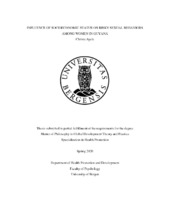| dc.description.abstract | Background: Lack of access to resources of development position Guyanese women vulnerable in economic and education contexts. Evidence suggests, socioeconomic status directly influences health outcomes. The available research surrounding the influences of sexual health behavior of women is limited and inconclusive. Objective: The objective of this study was to explore the extent education and household wealth influences birth control use and engaging with multiple partners. Also, how those socioeconomic influences transform when age, relationship status, and residence type are considered in the models. Methods: The Demographic Health Survey for Guyana from 2009 was used to conduct a quantitative study. Participants were women between the ages of 15 and 49 years old (n = 4,996). Chi-square for independence and logistic regression analyses were performed to explore the associations and odds of education and household wealth in relationship to birth control use and engaging with multiple partners. Multiple models were run in order to see what changes occurred when controlling for specific demographic variables. Results and Discussion: Socioeconomic factors were generally associated with risky sexual behavior but no conclusive statements can be made about the direction of socioeconomic status and risky sexual behavior’s relationship. Sequential changes among variable categories were not consistent outside of the relationship of wealth and engaging with multiple partners. As socioeconomic status increased, the odds of engaging in risky sexual behavior increased when controlling for age, relationship status, and residence type. Various factors can explain this adverse behavior including, but not limited to, upward mobility, education quality, and gender inequity. Conclusion: The results of this study were inconclusive but generally showed trends of increased risky sexual behaviors as socioeconomic status increased with noteworthy influence from control variables; age, relationship status, and residence type. The findings of this study highlight the necessity for further research of sexual behavior for the field of health promotion. | en_US |
